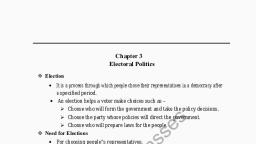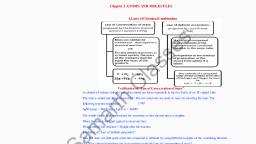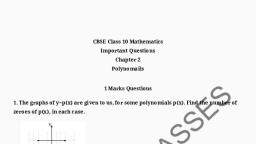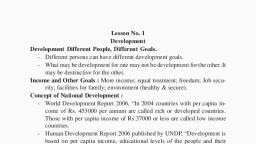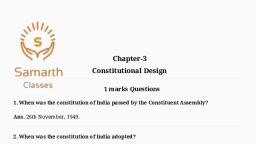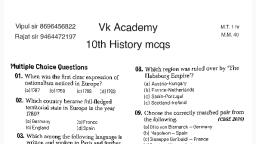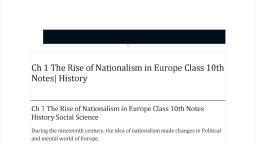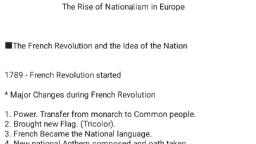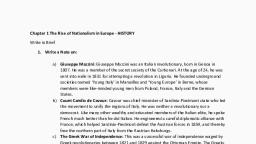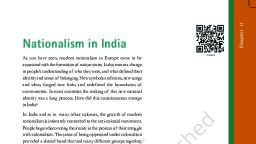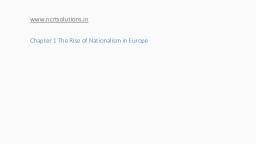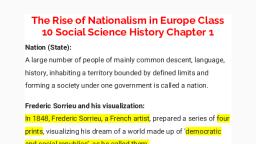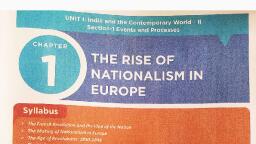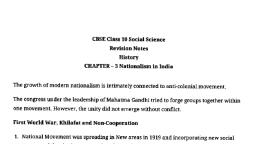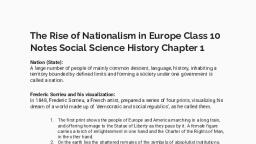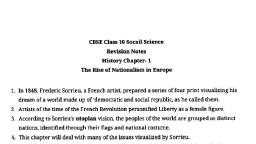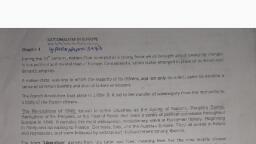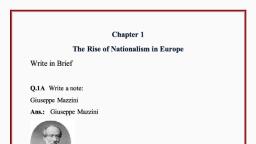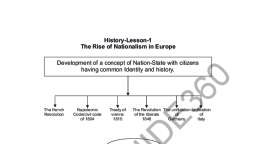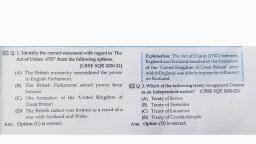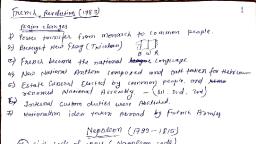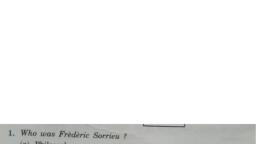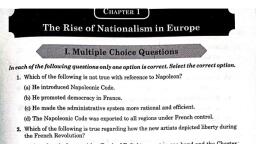Page 1 :
Unit 1: India & the Contemporary World ||, , , , , , , , , , Rise of Nationalism, in Europe, , Quick Revision, , Concept of Nation State, , During the 19th century nationalism emerged as a, force in Europe. It brought about sweeping, changes in the political and mental world of, Europe which resulted in emergence of the, nation-state., , Frederic Sorrieu and His Visualisation, , Frederic Sorrieu, a French artist drew a series of four, prints which depicted his dream of a world made up, of ‘Democratic and Social Republics’ in 1848., , The French Revolution, and the Idea of Nation, , e The first idea of nationalism came with the, French Revolution in 1789., , e The French Revolutionaries introduced various, measures and practices and introduced the ideas, like, da patrie (the fatherland) and le citoyen (the, citizen) amongst the French people., , ¢ A centralised administrative system and a, uniform law for all citizens was introduced., , Napoleonic Code, , e Napoleon had incorporated revolutionary, principle by introducing the Civil Code of 1804,, which was known as Napoleonic Code., , ¢ This civil code removed all privileges based on, birth, established equality before law and, secured the right to property. It abolished the, feudal system and freed peasants from serfdom, and manorial dues. It simplified administrative, divisions, removed guild system, improved, transport and communication system, introduced, , standardised weights and measures and common, national currency., , The Making of Nationalism in Europe, , e There were no nation-states in the mid-18th, century Europe., , ¢ Germany, Italy and Switzerland were divided, into kingdoms, duchies and cantons whose rulers, had their autonomous territories. They did not, see themselves as sharing a collective unity or a, common culture., , Aristocracy and the New Middle Class, , e Aristocracy, was a small group but it was the, dominant class in the continent. They owned, estates and property., , e Due to industrialisation the new social groups of, working class and middle class population,, including industrialists, businessmen,, professionals came into existence., , Liberal Nationalism, , e In the early 19th century, ideas of national unity, were closely related to the ideology of liberalism., , e For the new middle classes, liberalism meant, freedom for individual and equality of all before, law., , e In France, the right to vote and to get elected, was granted exclusively to persons who owned, property. Men without property and women, were excluded from this right., , e In the economic sphere, liberalism stood for the, freedom of markets and the abolition of state, imposed restrictions on the movement of goods, and capital.
Page 2 :
In 1834, a Customs Union or Zollverein was, formed by Prussia and accepted by most of, the German state., , The union abolished tariff barriers and, reduced the number of currencies from over, thirty to two., , A New Conservatism After 1815, , Following the defeat of Napoleon in 1815,, European governments were driven by a, spirit of conservatism., , Conservatism stressed on the importance of, tradition, established institutions and customs, and preferred gradual development to quick, change., , The European powers like Britain, Russia,, Prussia and Austria who had collectively, defeated Napoleon met at Vienna and signed, up the Treaty of Vienna in 1815. The, congress was hosted by the Austrian, Chancellor Duke Metternich and they drew up, the Treaty of Vienna of 1815., , The major outcomes of the treaty are the, Bourbon dynasty restored power, France lost, all the territories, annexed by Napoleon and, a series of states were set up on the, boundaries of France to prevent its expansion, in future., , The main intention of congress was to restore, the monarchies that has been overthrown by, Napoleon and create a new conservative, order in Europe., , The Revolutionaries, , The liberal nationalists opposed monarchial, forms that had been established after Vienna, Congress and fight for liberty and freedom., , In Italian revolutionary Giuseppe Mazzini, , became a member of secret society and, found two underground societies, viz, Young, , Italy and Young Europe., , His relentless opposition to monarchy made, Metternich to describe him as ‘the most, dangerous enemy of our social order’., , The Age of Revolution: 1830-1848, , Liberalism and nationalism was associated, with the revolution in many regions of, Europe such as the Italian and German states,, , the provinces of Ottoman Empire, Ireland and, Poland. These revolutions were led by liberal, nationalists., , The first upheaval took place in France in, , July 1830. The Bourbon kings were overthrown by, , liberal revolutionaries, who installed Louis Philippe, as the constitutional monarch., , There was a struggle for independence in Greece and, the Treaty of Constantinople of 1832 recognised, Greece as an independent nation., , The Romantic Imagination, and National Feeling, , Romanticism was a cultural movement that tried to, create a sense of a shared collective heritage as a, basis of a nation., , Some countries like Poland kept nationalist feeling, alive through music and language. The clergies in, Poland used Polish language for religious instruction., , Hunger, Hardship and Popular Revolt, , &, , The 1830s were the years of great economic hardship, in Europe., , There was enormous increase in population all over, the Europe and population from rural areas, migrated to cities to live in overcrowded slum., , The conditions of the workers in town was extreme., In 1845, there was a revolt of weavers in Silesia, village against the contractors., , In 1848, population of Paris revolted due to food, shortage and widespread unemployment., , Barricades were erected and Louis Philippe was, forced to flee., , As a result, a National Assembly proclaimed a, republic and granted suffrage to adult males above, 21 and guaranteed them the right to work. National, workshop were set-up to provide employment., , It was because the contractors supplied raw material, to weaver and reduced their payments., , As a result, suffrage (right to vote) was granted to, males above 21 by the National Assembly. This, gave them the right to work., , 1848 : The Revolution of the Liberals, , In Germany, Italy, Poland and Austro-Hungarian, empire demanded for constitutionalism with, national unification. The liberal took advantage of, the growing popular unrest to push their demands, for the creation of nation-state.
Page 3 :
e In 1848 France, Germany, Italy, Poland etc, demanded for a nation state based on Constitution,, freedom of the press and freedom of association., , e Monarchies of Central and Eastern Europe, wanted to introduce changes like that in Western, Europe exaboilish of serfdom and bonded, labour in Habsburg and Russia., , May Revolution, , e On 18th May, 1848, 831 elected representatives, assembled in the Church of St Paul. They, drafted a Constitution for German nation., According to this Constitution, the nation was to, be headed by a monarchy under a parliamentary, control., , e The highest position was offered to Friedrich, Wilhelm IV (King of Prussia), but he rejected it, and joined other monarchs to oppose the elected, assembly. The Parliament also lost its support as, demands of workers and artisans were ignored, and the assembly was disbanded., , Issue of Political Rights to Women, , ¢ Women were not given any political rights so, large number of women participated actively in, the liberal movements to demand for their rights., , e They formed their own political associations,, founded newspaper and took actively in political, meeting and demonstrations., , The Making of Germany and Italy, , After 1848, nationalist sentiments were widespread, in Germany and Italy which led to their, unification., , Unification of Germany, , e The middle class tried to unite the different, regions of German confederation into a nation-state., Prussia took the leadership of the movement., , e It’s Chief Minister Otto von Bismarck, aimed, to achieve the unification with the help of, Prussian army and bureaucracy., , e Prussian victory in three wars with Austria,, Denmark and France ended and completed the, process of its unification., , ¢ Chief Minister Otto von Bismarck along with, princes of German states, representatives of the, army, Prussian ministers declared the new, German Empire on 18th January, 1871. It was, headed by Kaiser William I of Prussia., , e Newly formed state, Germany emphasised on, modernising the currency, banking, legal and, judicial systems., , Unification of Italy, , e During the middle of the 19th century, Italy was, divided into seven states. Only, Sardinia-Piedmont was ruled by an Italian, Princely house., , e Giuseppe Mazzini, Count Camillo de Cavour,, Giuseppe Garibaldi took responsibilities to unite, Italy. Due to their effort Italy was united in 1861., , e In 1861 Victor Emmanuel II was proclaimed, the king of United Italy., , e The states of Tuscany, Modena, Parma and the, Papal were joined with Sardinia., , e The final unification of Italy was achieved in, 1871 and Rome became a part of Sardinia., , Growth of Great Britain, , ¢ There was no British nation prior to the 18th, century., , e The primary identities of the people in the, , British Isles were ethnic ones like English,, Welsh, Scot and Irish., , e The Act of Union (1707) between England and, Scotland resulted in the formation of the United, Kingdom of Great Britain. By this Act, Scotland, was incorporated in England., , e Ireland was forcibly incorporated into the, United Kingdom of Britain in 1801., , e The symbols of the new Britain were the British, flag (Union Jack), the National Anthem (God, save our Nobel King) and the English language., , Visualising the Nation, , e Artists in the 18th and 19th century started to, personify nations as female figures., , e These female figures became known as allegory of, nations, vizin France, Marianne was the allegory, and in Germany, Germania was the allegory., , Nationalism and Imperialism, , e A large part of the Balkans was under the, controls of the Ottoman Empire., , e Each European power i.e., Germany, Russia,, England, Austro-Hungary wanted to extend their, control over the Balkans. This led to series of, , war and finally the First World War.
Page 4 :
Objective Questions, , Multiple Choice Questions, , 01., , 02., , 03., , When was the first clear expression of, nationalism noticed in Europe?, , (a) 1787 (b)1759 (c)1789 (d)1769, , Which country became full-fledged, territorial state in Europe in the year, , 1789?, , (a) Germany, (c) England, , (b) France, (d) Spain, , Which among the following language is, written and spoken in Paris and further, accepted as a common language of that, nation?, , (a) English, (c) Spanish, , (b) French, (d) German, , 04. Which newly designed flag was chosen, , 05., , 06., , 07., , lu replace the formal flay ‘Royal, Standard’ in France?, , (a) Union Jack, (c)Red Cross, , (b) Tricolour, (d) White Satire, , Which of the following reforms made, , the whole system in France more, rational and efficient?, , (a) Social Reforms, , (b) Political Reforms, , (c) Administrative Reforms, (d) Economic Reforms, , Which of the following revolutions is, called as the first expression of, ‘Nationalism’? (CBSE 2020), , (a) French Revolution, , (b) Russian Revolution, , (c) Glorious Revolution, , (d) The Revolution of Liberals, , Which one of the following was not the, feature of Napoleonic Code?, , (a) Equality before the Law, Universal Adult Franchise, Right to property, , No Privileges based on birth, , (b), (c), (d), , 08., , 09., , 10., , 11., , 12., , 13., , Which region was ruled over by “The, Habsburg Empire’?, , (a) Austria-Hungary, , (b) France-Netherlands, , (c) Spain-Portugal, , (d) Scotland-lreland, , Choose the correctly matched pair from, the following. (CBSE 2020), , (a) Otto von Bismarck — Germany, (b) Napoleon — Spain, , (c) Giuseppe Garibaldi — France, (d) Bourbon Kings — Italy, , What was the main feature of the, pattern of land holding prevailing in the, Eastern and Central Europe?, , (b) Landlords, (d)Small Owners, , (a) Tenants, (c) Vast Estates, , Which among the following best, signifies the idea of liberal nationalism, of nineteenth century Europe?, , (a) Emphasis on social justice, , (b) State planned and socio-economic system, , (c) Freedom of the individual and equality, before law, , (d) Supremacy of State oriented nationalism, , “When France sneezes, the rest of, Europe catches cold”. Who among the, following said this popular line?, , (a) Guiseppe Mazzini (CBSE 2020), , (b)Matternich, (c) Otto von Bismarck, (d) Guiseppe Garibaldi, , Find the incorrect option., , (a) Treaty of Vienna was signed in 1845., , (b) Sardinia-Piedmont was ruled by an Italian, Princely House., , (c) Victor Emmanuel II was proclaimed the king, of United Italy., , (d) During the 19th Century nationalism, emerged as force in Europe.
Page 5 :
14., , 15., , 16., , 17., , 18., , Which one of the following is true, , regarding the ideas promoted by Mazzini?, , (a) Opposition to Monarchy and support to, democratic republic., , (b) To establish liberty and freedom under a, Monarchy., , (c) Disintegration of the German Confederation, under 3Y states., , (d) Censorship of newspapers, books, plays and, songs., , The Nationalist Greeks got the support, of the West European nations because, , Ottoman Empire., , (b) They had sympathies for ancient Greek, culture., , (c) Greece was considered the cradle of, European civilisation., , (d) All of the above, , Which one of the following was not, , implemented under the Treaty of Vienna, of 1815?, , (a) Restoration of Bourban dynasty., , (b) Setting up series of states on the boundaries, of France., , (c) Restoration of Monarchies, (d) Diluting the German confederation of 39 states., , Which one of the following was NOT, , the result of the Treaty of Vienna 1815?, (CBSE 2020), , (a) The Kingdom of the Netherlands was setup, in the North., (b) Austria was given control of Northern Italy., , (c) Prussia was given important new territories, on its Western frontiers., , (d) Russia was given German confederation of, 39 states., , The main function of the Prussian, Zollverian was to ............. ., , (a) Impose customs duty on imported goods, (b) Abolish tariff barriers, , (c) Reduce custom duties, (d) Introduce new rules for trade, , 19. Which among the following best, signifies the idea of liberal nationalism, of nineteenth century Europe?, , (a) Emphasis on social justice, (b) State planned socio-economic system, , (c) Freedom for individual and equality before, law, , (d) Supremacy of State oriented nationalism., , 20. Find the incorrect option., , (a) The Napoleonic Code (Civil Code) was, introduced in 1804., , (b) 1830's was the period of great economic, hardship in Europe., , (c) Count Camillo de Cavour was central, figure in the unification of Italy., , (d) In 1831, an armed rebellion against Russian, Rule took place., , 21. Which one of the following is true, , regarding the Treaty of Constantinople, , , , of 1832?, , (a) It recognised Turkey as an Independent, nation., , (b) It recognised Germany as an Independent, nation., , (c) It recognised France as an Independent, nation., , (d) It recognised Greece as an Independent, nation., , 22. Conservatives did not believe in, , establishing and preserving, , (a) The Monarchy, , (b) The Democracy, , (c) Social Hierarchies, , (d) Traditional institutions of state and society, , 23. Identify the correct statement with, , regard to “The Act of Union, 1707’, from the following options., , (a) The British monarchy surrendered the, power to English Parliament., , (b) The British Parliament seized power from, Ireland., , (c) The formation of the ‘United Kingdom of, Great Britain’., , (d) The British nation was formed as a result, of awar with Scotland and Wales.


